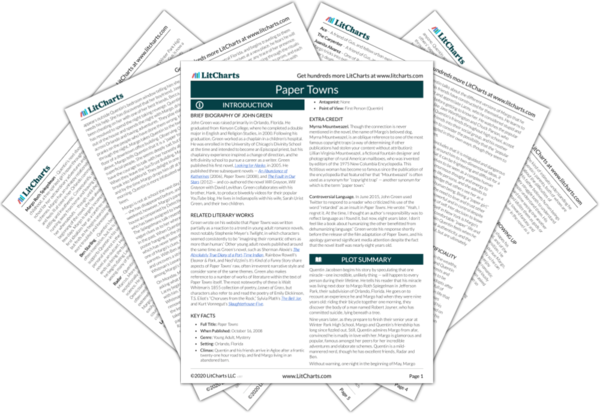Quentin discovers Walt Whitman’s “Song of Myself” as part of his search for Margo, but as he progresses in his investigation — turning his attention as he does from Margo and her intentions, to himself and the many ways that he has misunderstood and mis-imagined Margo —the poem becomes a platform for Quentin to being formulating a more generous, compassionate, and humble way of relating to others. Whitman is a tremendously empathetic poet, who believes that all people are interconnected, and through their connections can learn, not only to understand one another, but to become one another. When Quentin finally talks to Margo about the poem at the end of the novel, though, he questions the accuracy of Whitman’s operative philosophy. He is less optimistic than Whitman, because his experience of searching for Margo has taught him how difficult it can be to really connect with and understand another person, but he does draw from Whitman’s optimism in crafting his own philosophy of human connection. Quentin’s image of human beings as vessels whose cracks allow others to see them clearly, borrows Whitman’s optimism to construct a generous vision for how human beings can come to love one another in spite of and because of their flaws.
“Song of Myself” Quotes in Paper Towns
The Paper Towns quotes below all refer to the symbol of “Song of Myself”. For each quote, you can also see the other characters and themes related to it (each theme is indicated by its own dot and icon, like this one:
).
Part 3, Agloe
Quotes
She can see it in my face — I understand now that I can’t be her and she can’t be me. Maybe Whitman had a gift I don’t have. But as for me: I must ask the wounded man where he is hurt, because I cannot become the wounded man. The only wounded man I can be is me.
Related Characters:
Related Symbols:
Page Number and Citation:
Explanation and Analysis:
Get the entire Paper Towns LitChart as a printable PDF.

“Song of Myself” Symbol Timeline in Paper Towns
The timeline below shows where the symbol “Song of Myself” appears in Paper Towns. The colored dots and icons indicate which themes are associated with that appearance.
Part 2, Chapter 4
...Quentin spends the rest of the afternoon reading the longest poem in the book, called “Song of Myself.” He notices that Margo has highlighted many lines in blue, but that two are highlighted...
(full context)
Part 2, Chapter 5
Radar is certain that the two lines in “Song of Myself” that Margo highlighted in green — about removing doors from their jambs —contain Margo’s next...
(full context)
Part 2, Chapter 9
...that the stench has not been coming from Margo. Still, Quentin can’t help thinking about “Song of Myself,” with its many lines about the beauty of death, and wondering whether it might have...
(full context)
Part 2, Chapter 10
At home, Quentin reads “Song of Myself” and tries to determine whether it is “a suicide-note kind of poem.” He soon becomes...
(full context)
Part 2, Chapter 11
...about Moby-Dick during English, it occurs to Quentin that she might have helpful insights about “Song of Myself.” After class, he brings Dr. Holden the poem and points out the morbid trend in...
(full context)
...as a means for one person to understand another, but she encourages him to read “Song of Myself” all the way through, saying a poem cannot “do its work” unless it’s read in...
(full context)
Part 2, Chapter 12
...where there was no internet, television, or music. His boredom ultimately leads Quentin back to “Song of Myself,” which he has brought with him. For the first time, he finds that he can...
(full context)
Quentin lingers over one part of “Song of Myself” in which a child asks the poet what grass is. Whitman gives many answers: that...
(full context)
Part 2, Chapter 17
In bed, Quentin pages through “Song of Myself.” He looks at the map pinned to his wall, and thinks of how fruitless it...
(full context)
Part 2, Chapter 19
Reading “Song of Myself” that night, Quentin pauses over one line: “I do not ask the wounded person how...
(full context)














